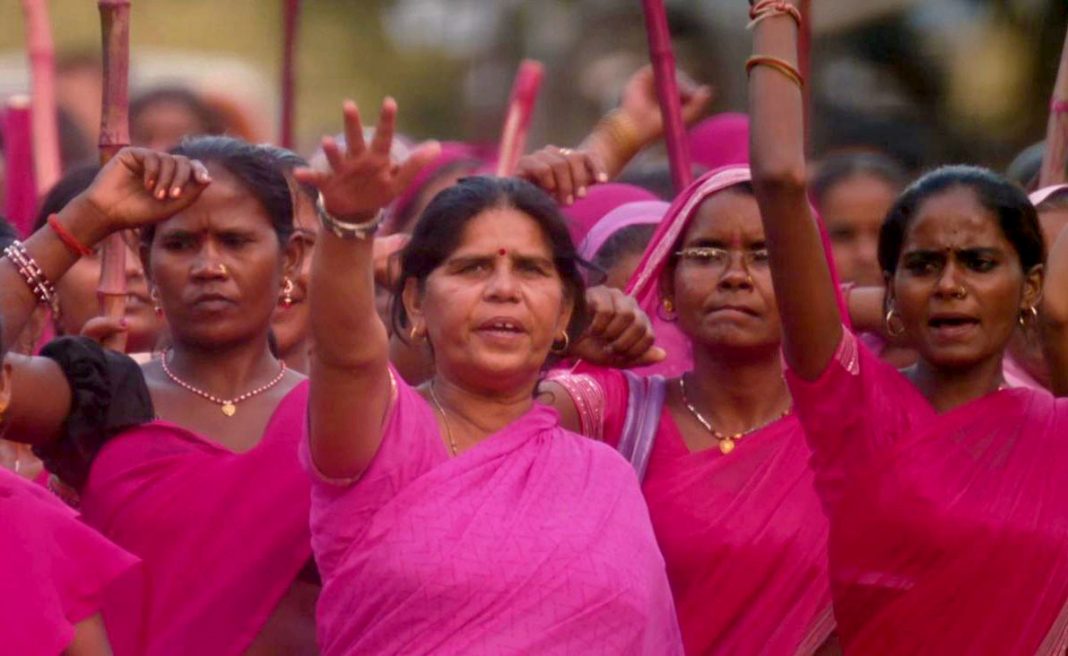Nothing strikes harder than a bamboo stick in the hands of a woman wearing a pink saree. What is a better way to kick off the celebration of International Women’s Day than by spotlighting India’s very own women’s vigilante group? The Gulabi Gang (aka the Pink Gang) of India is a women’s rights group that fights for justice toward violence against women, especially domestic abuse. The “lathi,” or a heavy stick, has become a symbol for the Gulabi Gang as an alternate method of justice. With more than 200,000 members across 11 districts in Uttar Pradesh, India, the power, progress, and empowerment of the Gulabi Gang has inspired documentaries, a Blockbuster Bollywood movie starring iconic actresses Madhuri Dixit and Juhi Chawla, and many scholarly books such as the Pink Sari Revolution.
Founder of the Gulabi Gang Sampat Pal Devi first used the lathi in the 1980s when she witnessed her neighbour abusing his wife. Devi herself was married off at the age of 12 and pregnant with her first child by 15. The province of Uttar Pradesh ranks as one of the most unsafe provinces for women in the country, with a staggering amount of rape, kidnapping, and cases of dowry death. It is also a region that is riddled with police and political corruption, leading to a virtually non-existent support structure for women who are victims of domestic and sexual abuse.
Devi founded the Gulabi Gang in 2006 in response to the lack of police support for women, especially those of lower castes that face extreme poverty and barriers to education. In 2011, she learned about the case of Sheelu Nishad, a 17-year old housemaid for a powerful politician, who was raped by said politician and then thrown in jail under false charges of theft. The Gulabi Gang did not hesitate to interfere and fight against the corrupt justice system by sustaining a strong grassroots campaign that resulted in Nishad’s release and the conviction of the politician. This case and the gang’s interference caught international attention because of how a group of women in pink sarees, aged 18 to 60, stood up against an extremely misogynistic and patriarchal system and won.
The gang’s primary tactics are marches, occupations, campaigning, and discussions with NGOs and political organisations. If all fails, then they pick up their bamboo lathis and march to the houses of the men that abuse, rape, and kill women. Devi boasted that “we fight with lathis. If we find the culprit, we thrash him black and blue so he dare not attempt to do wrong to any girl or a woman again.”
The Gulabi Gang teaches women self-defence and how to be economically independent. The gang is also supported by other activist groups across the country that asked to join hands in their movements, such as the Banda farmers protest, food distribution to villagers, and helping the elderly and widows. Each movement developed the group’s reputation and recognition in India.
Criminal charges of illegal rioting and demonstrations are not uncommon for the Gulabi Gang, but even local police agree that they do good work in resolving deeply rooted social issues. One of the commanders of the gang, Suman Sigh, said that “when a woman seeks the membership of Gulabi Gang, it is because she has suffered injustice, has been oppressed, and does not see any other recourse.” The colour pink was chosen as their symbol because it has no political or religious associations in India, allowing them to transcend caste, religion, gender, and economic status when fighting for justice. They pressure police to investigate cases, organize protests, and capture international attention to their cause.
It is because of their continued efforts for justice and women’s rights in India’s rural regions that the Gulabi Gang earned the Kelvinator 11th GR8. Women Award by the Indian Television Academy and the Godfrey Phillips Bravery Award for social bravery offered in Uttar Pradesh, Uttarakhand, and Delhi. They even received several corporate partnerships with companies like Vitalect and Social Solution India. The story of the Gulabi Gang is one that originates from the abuse of women. It is this traumatic context that empowers these women to put on their pink sarees and fight violence against women, child marriages, dowry, and female illiteracy. Above all, the Gulabi Gang works to ensure the most impoverished populations in India maintain their basic human rights. Their mission to “protect the powerless from abuse and fight corruption” has resonated across India and the world.



